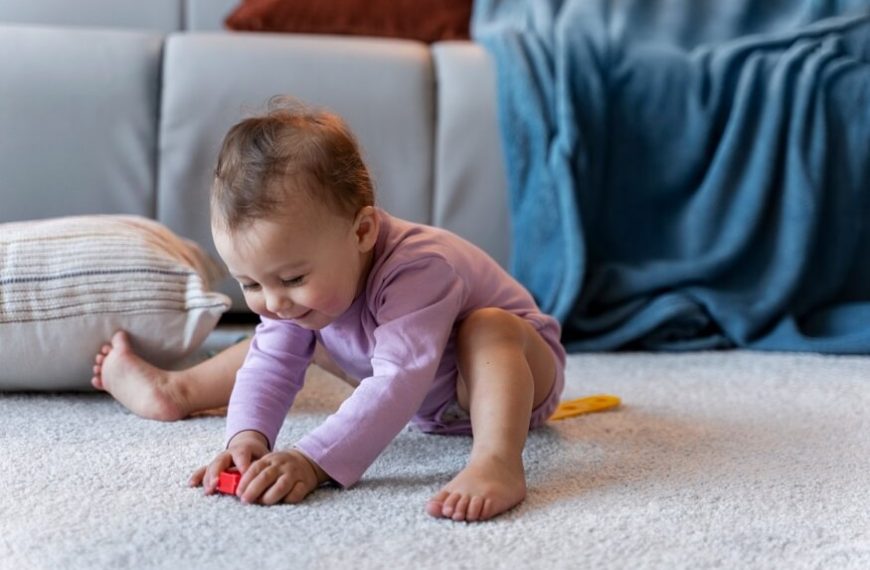Watching a baby grow and develop is a fascinating journey. Among the many milestones, one that parents eagerly await is the development of object permanence. Object permanence represents a significant cognitive leap in a baby’s life, signifying their understanding that objects persist even when hidden from view. In this blog, we’ll thoroughly explore what object permanence is, unravelling its essence, significance, typical developmental timeline, and the various stages it encompasses. Furthermore, we’ll illustrate this concept with real-life examples, offering valuable insights, especially for parents and caregivers in India.
What is Object Permanence?
Imagine engaging in a round of peek-a-boo with a baby, a timeless game that elicits smiles and laughter. As you playfully cover your face, the baby’s initial reactions may span from bewilderment to curiosity. They might even believe you’ve mysteriously vanished. But, as the game unfolds, they gradually grasp the concept – you haven’t disappeared; you’re still right there. This evolving awareness is what we call object permanence.
Object permanence, in essence, represents the baby’s realisation that objects persist even when temporarily hidden from view. It’s akin to their understanding that a cherished toy remains tucked beneath the blanket, even when temporarily concealed. Although this cognitive skill may appear minor, it signifies a significant milestone in a baby’s development journey.
Why is Object Permanence Important?
Object permanence is a vital cognitive skill for several reasons:
Enhanced Problem-Solving: Object permanence allows babies to mentally manipulate objects in their minds, which is a crucial skill for problem-solving. This ability helps them understand the cause-and-effect relationship, such as realising that a hidden toy can be retrieved by moving an obstacle.
Emotional Development: Additionally, object permanence contributes to emotional development. As a baby comprehends that their caregiver persists in existence even when temporarily out of sight, it nurtures a sense of security and trust within the relationship.
Language Development: As babies develop object permanence, they can grasp the concept of words and symbols representing objects. This lays the foundation for language development and communication.
Spatial Awareness: Understanding object permanence contributes to a child’s spatial awareness and navigation skills. It helps them navigate their environment more effectively and avoid obstacles.
When Does Object Permanence Develop?
The development of object permanence is a gradual process that occurs in distinct stages. While the exact timing can vary from one child to another, there is a general timeline for when object permanence typically develops:
- Birth to 4 Months:
- 4 to 8 Months:
- 8 to 12 Months:
- 12 to 18 Months:
During this stage, babies are in the sensorimotor stage of cognitive development, according to Piaget’s theory. At this early age, infants lack object permanence. They are primarily focused on sensory experiences and can’t comprehend that objects exist when they are out of sight.
Around the four-month mark, babies start to exhibit the early signs of object permanence. They may briefly search for a hidden object if it disappears from their sight. However, their understanding is limited, and they may quickly forget about the object.
This is a critical period for the development of object permanence. Babies in this age range become more proficient at understanding that objects continue to exist when hidden. You may notice them actively searching for hidden objects and showing excitement when they find them.
By this stage, most babies have a solid grasp of object permanence. They can search for hidden objects even if they are covered for a longer duration. They understand that objects continue to exist even when they are not visible.
Object Permanence Example
Let’s look at an example to better understand what object permanence is. For a little moment, imagine yourself having a conversation with a baby who is seven months old. You put the baby in front of a colourful toy block that you have. He eagerly reaches for it, but you swiftly cover it with a rag, blocking his vision.
At this age, the baby is in the early stages of developing object permanence. Initially, he may look puzzled, wondering where the block disappeared. However, after a few moments of curiosity, he may pull the cloth away, revealing the hidden block. This act of searching for the object demonstrates the baby’s growing understanding of object permanence.
Stages of Object Permanence
As mentioned earlier, the development of object permanence occurs in stages. Swiss psychologist Jean Piaget outlined these stages in his theory of cognitive development:
- Stage 1: Reflexes (0-1 Month):
- Stage 2: Primary Circular Reactions (1-4 Months):
- Stage 3: Secondary Circular Reactions (4-8 Months):
- Stage 4: Coordination of Secondary Circular Reactions (8-12 Months):
- Stage 5: Tertiary Circular Reactions (12-18 Months):
During the first month of life, infants rely on reflexes for interaction with the world. They react to stimuli but have no idea of object permanence. They may, for example, suck on a dummy while it is in their mouth but lose interest when it is removed.
In this stage, infants start to repeat actions they find pleasurable, such as sucking their thumb. However, they still don’t grasp object permanence and may lose interest in objects once they are out of sight.
This is the stage where object permanence begins to emerge. Babies become more interested in objects and may briefly search for them if they disappear from their sight. They are starting to understand that objects exist even when hidden temporarily.
During this stage, infants become more deliberate in their actions. They actively search for hidden objects and show excitement when they find them. Their understanding of object permanence becomes more solid.
In this final stage related to object permanence, infants begin to explore the world through trial and error. They may engage in more complex behaviours to find hidden objects, such as lifting blankets or moving obstacles. Their understanding of object permanence is well-established.
Gaining insight into object permanence and its developmental stages holds significant importance for parents and caregivers in India. This cognitive milestone serves as a cornerstone for various aspects of a child’s growth, including problem-solving, emotional development, language proficiency, and spatial awareness. By identifying the typical progression of object permanence in babies and understanding how it unfolds, you can effectively nurture your child’s cognitive development.
For more such interesting blogs, Visit EuroKids.
















